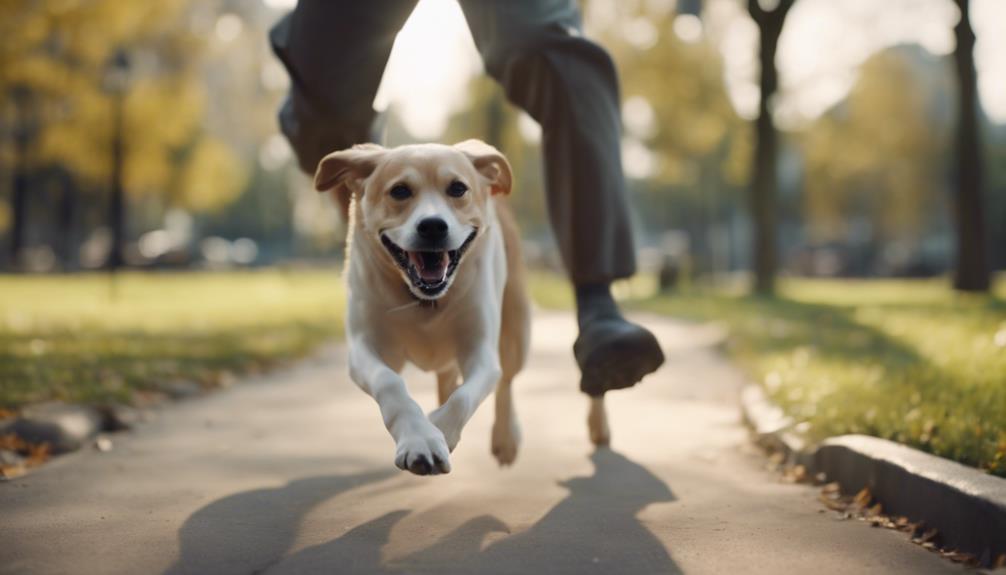Within the realm of canine health, Elbow Dysplasia emerges as a significant challenge that can profoundly affect a dog's quality of life. This genetic condition, characterized by joint abnormalities, presents hurdles that demand careful navigation.
Despite the potential obstacles, there exists a nuanced approach to managing Elbow Dysplasia that enables dogs to thrive. By exploring the intricacies of this ailment and the array of strategies available to support affected pets, a path emerges towards helping our furry companions lead fulfilling lives despite the constraints posed by this condition.
Key Takeaways
- Proper management and treatment can help dogs with elbow dysplasia maintain an active lifestyle.
- Monitoring weight, diet, and exercise is essential for reducing joint stress and managing the condition.
- With timely diagnosis and interventions, dogs with elbow dysplasia can live comfortably and happily.
- Veterinary care, lifestyle adjustments, and treatment adherence can significantly improve the quality of life for affected dogs.
Symptoms and Diagnosis of Elbow Dysplasia
Upon onset of elbow dysplasia, dogs may exhibit symptoms such as lameness in their front legs and stiffness, prompting the need for a thorough clinical examination and diagnostic imaging for an accurate diagnosis. These symptoms can manifest as reluctance to exercise and turned out feet.
Diagnosis typically involves a comprehensive clinical examination, including gait assessment, joint manipulation, and palpation to identify specific areas of discomfort. X-rays are commonly used to detect abnormalities in the elbow joint, while more advanced imaging techniques like CT scans or MRI may be necessary for a definitive diagnosis.
Early detection and diagnosis are essential in managing elbow dysplasia effectively, as prompt intervention can help alleviate discomfort and improve the overall prognosis for affected dogs.
Treatment Strategies for Elbow Dysplasia
Effective management of elbow dysplasia in dogs involves a comprehensive approach that includes various treatment strategies tailored to alleviate pain and delay the onset of osteoarthritis. When dealing with elbow dysplasia in dogs, the following treatment options can be considered:
- Non-Steroidal Anti-Inflammatory Drugs (NSAIDs): Prescribed by veterinarians to help manage pain and discomfort in dogs with elbow dysplasia.
- Glucosamine: Can aid in maintaining joint health and supporting cartilage in affected dogs.
- Physical Therapy: Exercises and modalities designed to improve strength, range of motion, and overall mobility in dogs with elbow dysplasia.
These treatment strategies, when combined and tailored to the individual dog, can significantly enhance their quality of life and help them remain active and happy.
Surgical Options for Elbow Dysplasia

When non-invasive treatment strategies for elbow dysplasia in dogs do not provide sufficient relief, surgical options become a crucial consideration for addressing the condition and improving the affected dog's quality of life.
Surgical interventions for elbow dysplasia aim to correct joint incongruity, remove bone fragments, or address cartilage damage to alleviate pain and improve mobility. Procedures such as arthroscopy, osteochondral autograft transfer, joint replacement, or even corrective osteotomies may be recommended based on the severity and specific characteristics of the individual case.
It is essential for pet owners to consult with a veterinary orthopedic specialist to determine the most appropriate surgical approach tailored to their dog's condition, ultimately aiming to restore functionality and enhance the well-being of the furry companion.
Pain Management in Elbow Dysplasia
Implementing a comprehensive pain management protocol is essential in ensuring the comfort and well-being of dogs affected by elbow dysplasia. Proper pain management strategies can significantly improve the quality of life for these animals.
Here are three key components of an effective pain management plan:
- Non-Steroidal Anti-Inflammatory Drugs (NSAIDs): Prescribed by veterinarians, NSAIDs help alleviate discomfort and reduce inflammation in dogs with elbow dysplasia.
- Physical Therapy: Incorporating physical therapy exercises can help strengthen muscles, improve joint flexibility, and alleviate pain in affected limbs.
- Weight Management: Maintaining a healthy weight through proper diet and exercise is crucial in reducing joint stress and discomfort for dogs with elbow dysplasia.
Lifestyle Modifications for Elbow Dysplasia

To enhance the well-being of dogs with elbow dysplasia, incorporating specific lifestyle modifications can play a pivotal role in managing the condition and improving their quality of life.
Maintaining an ideal weight through a balanced diet and portion control is crucial to reduce stress on the affected joints. Providing comfortable bedding and ensuring a warm and dry environment can help alleviate discomfort.
Implementing low-impact exercises such as swimming or short, controlled walks can help improve muscle strength and joint flexibility without causing excessive strain. Additionally, minimizing activities that involve jumping or running on hard surfaces can prevent further damage to the elbows.
Exercise and Physical Therapy for Elbow Dysplasia
Incorporating appropriate exercise regimens and tailored physical therapy sessions are vital components in the comprehensive management of elbow dysplasia in dogs. These interventions can help improve your pup's mobility, reduce pain, and enhance their overall quality of life.
Here are three key points to consider:
- Low-Impact Exercises: Engage your dog in activities like swimming or controlled leash walking to strengthen muscles without causing excessive strain on the affected elbows.
- Physical Therapy: Work with a professional to develop a customized physical therapy plan focusing on improving range of motion, muscle strength, and joint flexibility.
- Consistency is Key: Regularly follow the exercise and physical therapy routine to ensure long-term benefits for your dog's elbow dysplasia management.
Dietary Considerations for Elbow Dysplasia

Considering the impact of nutrition on the management of elbow dysplasia in dogs is essential for optimizing their overall health and well-being. A balanced diet can help maintain a healthy weight, reduce inflammation, and support joint health. When selecting food for a dog with elbow dysplasia, look for options rich in omega-3 fatty acids, glucosamine, chondroitin, and antioxidants. These nutrients can aid in reducing pain and inflammation associated with the condition. Additionally, consulting with a veterinarian or canine nutritionist can help tailor a diet plan specific to your dog's needs. Below is a table highlighting key dietary considerations for dogs with elbow dysplasia:
| Nutrient | Function | Food Sources |
|---|---|---|
| Omega-3 Fatty Acids | Reduce inflammation and support joint health | Salmon, flaxseeds, chia seeds |
| Glucosamine | Supports joint health | Shellfish, bone broth |
| Antioxidants | Reduce oxidative stress | Blueberries, spinach, kale |
Long-Term Outlook for Elbow Dysplasia
Dogs diagnosed with elbow dysplasia can lead fulfilling lives with proper management and care. Despite being a chronic condition, there are several key factors that contribute to the long-term outlook for dogs with elbow dysplasia:
- Regular Veterinary Check-ups: Scheduled visits ensure timely adjustments to treatment plans and early detection of any worsening symptoms.
- Adherence to Treatment Plans: Consistency in administering medications and following therapeutic recommendations is crucial for maintaining the dog's comfort and mobility.
- Lifestyle Modifications: Implementing appropriate exercise routines, weight management strategies, and joint-friendly activities can significantly enhance the quality of life for dogs with elbow dysplasia.
Conclusion
In conclusion, Elbow Dysplasia in dogs poses a significant challenge to their mobility and overall well-being. By recognizing the symptoms early, pursuing appropriate treatment, and implementing lifestyle modifications, dogs diagnosed with this condition can lead fulfilling lives.
With a combination of veterinary care, tailored exercise regimens, and dietary considerations, the long-term outlook for dogs with Elbow Dysplasia can be improved, allowing them to enjoy life to the fullest despite the challenges they may face.




